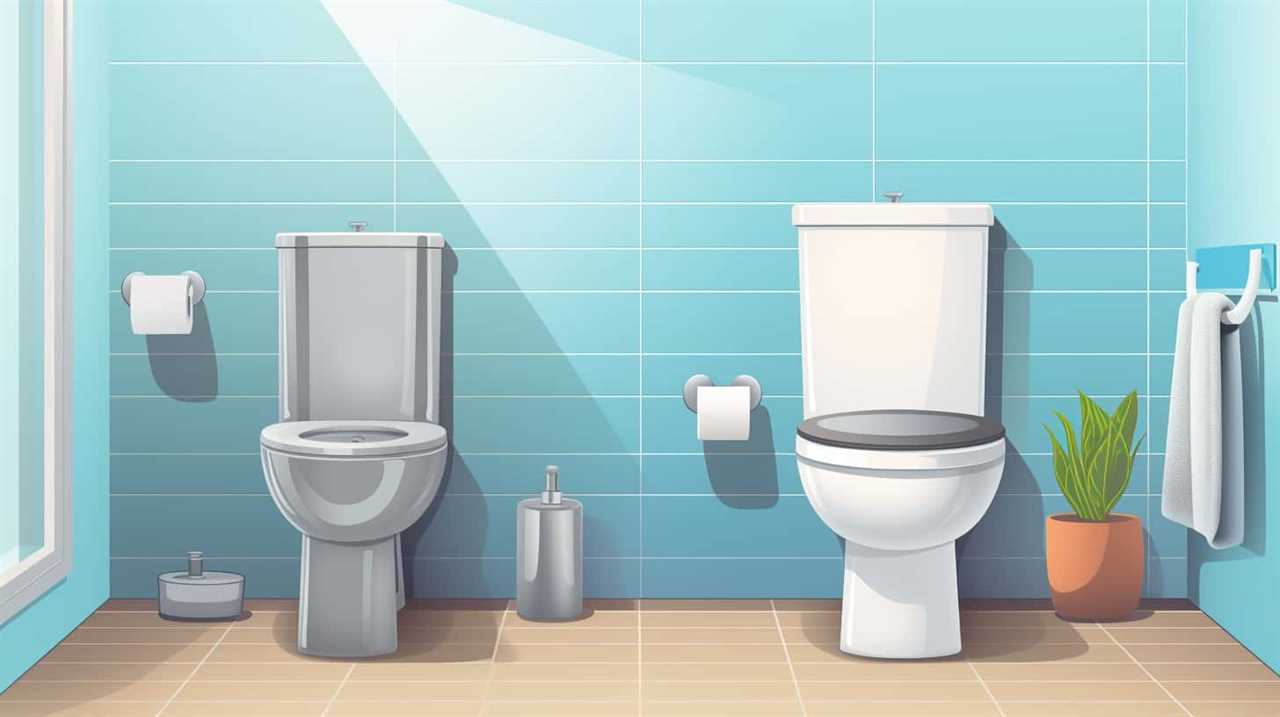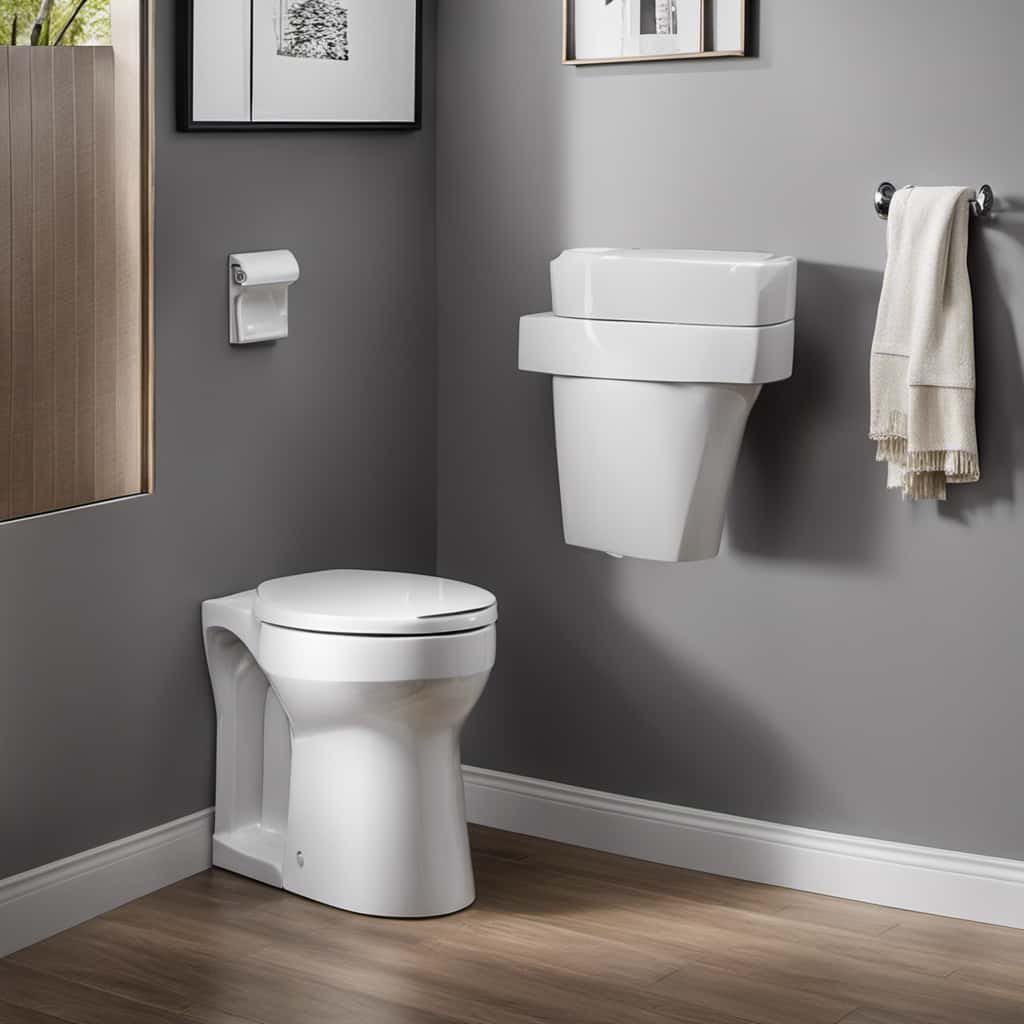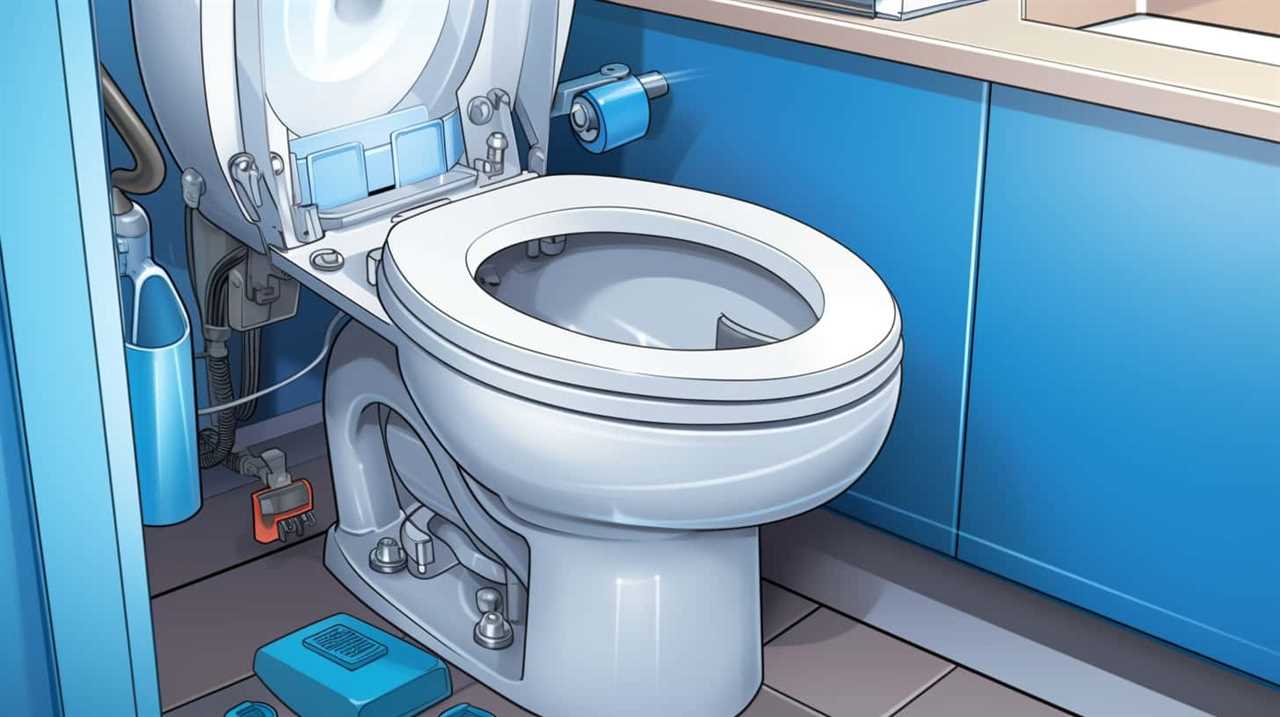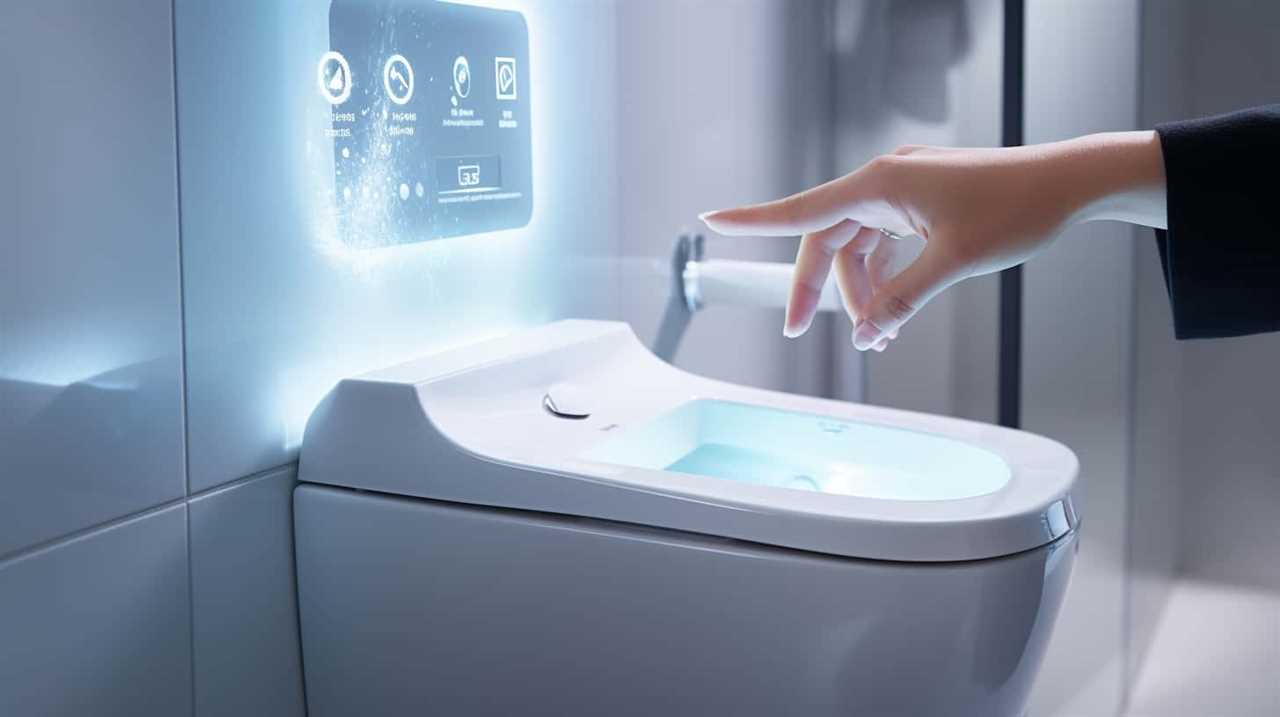Toilet Types
How to Dispose of Old Toilet

I’ve been staring at my old toilet for far too long, wondering how to get rid of it responsibly. If you’re in the same boat, fear not! I’ve done the research and compiled a step-by-step guide on how to dispose of your old toilet.
From assessing its condition to finding recycling centers, this article will walk you through the process. So, let’s dive in and bid farewell to that porcelain throne in an environmentally friendly way.
Key Takeaways
- Assess the condition of the old toilet for cracks, leaks, or damage.
- Research local disposal regulations and options specific to your area.
- Determine if the old toilet can be recycled and check with local recycling facilities.
- Find a recycling center or program for proper toilet disposal, or consider donating or repurposing the toilet.
Assess the Condition of Your Old Toilet
Before you can dispose of your old toilet, you’ll need to assess its condition. Assessing the toilet condition is crucial in determining its recycling eligibility.
Start by examining the porcelain for any cracks or chips. If the damage is minor, it can likely be repaired and reused.
Next, check the flushing mechanism. Ensure that it operates smoothly and effectively, without any leaks or blockages.
Inspect the tank and bowl for any signs of corrosion or rust. If the toilet shows significant wear and tear, it may not be suitable for recycling.
Additionally, consider the age of the toilet. Older toilets may not meet current water efficiency standards and should be replaced.
Research Local Disposal Regulations and Options
Researching your local area’s regulations and options for disposing of a toilet is essential. When it comes to getting rid of an old toilet, you need to be aware of the rules and guidelines set by your local government.
Start by researching the specific regulations in your area. Some regions may require you to contact a licensed plumber or waste management company to handle the disposal. Others may allow you to dispose of the toilet with your regular garbage collection, as long as it is properly wrapped and labeled. It is important to follow these regulations to avoid fines or legal issues.
Additionally, look into any recycling or donation programs that may be available in your area. Recycling your old toilet can help reduce waste and benefit the environment.
Determine if Your Old Toilet Can Be Recycled
Determining if your old toilet can be recycled is an important step in the disposal process.
When it comes to recycling eligibility, there are a few factors to consider. First, check with your local recycling facility to see if they accept toilets for recycling. Some facilities have specific guidelines or restrictions, so it’s crucial to be aware of them.
Additionally, the material of your toilet plays a significant role. Most toilets are made of porcelain, which is recyclable. However, if your toilet has any non-porcelain components like metal or plastic parts, you may need to remove them before recycling.
Find a Recycling Center or Program for Toilet Disposal
When it comes to disposing of old toilets, there are several recycling options available.
Proper toilet disposal is not only important for environmental reasons, but also for ensuring that the materials are recycled and reused efficiently.
To locate recycling centers or programs for toilet disposal, it is advisable to consult local waste management authorities or check online directories that provide information on recycling facilities in your area.
Recycling Options for Toilets
If you’re unsure about recycling options for your old toilet, you can check with your local waste management facility. They can provide information on toilet recycling programs and eco-friendly disposal methods available in your area.
Toilet recycling programs are designed to divert old toilets from ending up in landfills and instead recycle the materials for reuse. These programs typically accept porcelain toilets and may have specific guidelines for drop-off or pick-up.
Recycling toilets not only helps reduce waste but also conserves resources by reusing materials like porcelain and metal. Some facilities may require you to remove any non-recyclable parts, such as the toilet seat or wax ring, before recycling.
Proper Toilet Disposal
When it comes to toilet disposal methods, it is important to consider eco-friendly waste management practices. Here are some options to properly dispose of old toilets:
-
Recycling: Look for recycling centers that accept toilets. Many recycling facilities have programs in place to break down and recycle the different components of a toilet, such as porcelain and metal parts.
-
Donation: Consider donating your old toilet to a nonprofit organization or community center that may need it for renovations or construction projects.
-
Reuse: If your toilet is still in good condition, you can repurpose it in your garden as a planter or use it for other creative DIY projects.
-
Professional removal: Hire a professional waste management company that specializes in toilet disposal. They will ensure that your toilet is disposed of in an environmentally friendly manner.
-
Landfill: If no other options are available, consult your local waste management guidelines to determine the proper landfill disposal method.
Now that we understand the proper toilet disposal methods, let’s move on to the next section, which focuses on locating recycling centers.
Locating Recycling Centers
Now that we know the importance of eco-friendly waste management, let’s talk about finding recycling centers in your area. Locating recycling facilities is crucial for proper waste disposal and reducing our environmental impact. To help you in your search, I have provided a table below with information on some recycling centers in different regions. Remember to follow recycling guidelines when disposing of your waste, such as separating materials and rinsing containers. By recycling, we can divert waste from landfills and conserve valuable resources. Together, we can make a positive impact on the environment.
| Recycling Center | Address | Contact Number |
|---|---|---|
| Green Earth Recycling | 123 Main St, City A | 555-1234 |
| Eco-Friendly Disposal | 456 Elm St, City B | 555-5678 |
| Earth Saver Recyclers | 789 Oak St, City C | 555-9012 |
| Sustainable Solutions | 321 Maple St, City D | 555-3456 |
| Green World Recycling | 654 Pine St, City E | 555-7890 |
Remember to check with your local authorities for more information on recycling centers in your area. Let’s do our part in preserving the planet for future generations.
Prepare Your Old Toilet for Disposal
To prepare your old toilet for disposal, you’ll need to remove the tank and bowl from the base. Here’s a step-by-step guide on how to do it:
-
Assess the condition of your toilet. Check for any cracks, leaks, or damage that may affect its disposal.
-
Research disposal regulations in your area. Some places have specific rules on how to dispose of toilets, such as recycling options or designated drop-off locations.
-
Turn off the water supply and flush the toilet to empty the tank and bowl.
-
Disconnect the water supply line and remove the tank from the bowl by unscrewing the bolts.
-
Finally, remove the bowl from the base by unscrewing or unbolting it.
Once your old toilet is prepared for disposal, you can now arrange for transportation or pickup.
Arrange for Transportation or Pickup of the Old Toilet
You can easily arrange for the transportation or pickup of your old toilet once it is prepared for disposal.
There are several transportation options available to ensure a smooth and hassle-free process. One option is to contact your local waste management or sanitation department and inquire about their pickup services. They may have specific guidelines and requirements for toilet disposal, so it is essential to follow their instructions.
Another option is to hire a professional waste disposal company that specializes in handling and transporting bulky items like toilets. They will have the necessary equipment and expertise to safely remove and transport your old toilet.
Additionally, consider exploring donation possibilities for your old toilet. Non-profit organizations such as Habitat for Humanity may accept used toilets in good condition to be reused or sold to support their initiatives. Remember to reach out to these organizations beforehand to ensure they are accepting donations and to inquire about any specific requirements they may have.
Dispose of Your Old Toilet in an Environmentally Responsible Manner
When it comes to disposing of an old toilet, there are several key points to consider.
First, it’s important to explore the recycling options available in your area. Many municipalities have programs in place to collect and recycle old toilets, turning them into new products.
Second, proper waste management is crucial in ensuring that the toilet is disposed of in an environmentally responsible manner. This may involve following specific guidelines for packaging and transportation to a recycling facility.
Lastly, it’s essential to consider the environmental impact of disposing of a toilet. By recycling, we can help reduce the amount of waste sent to landfills and conserve valuable resources.
Recycling Options Available
There’s a variety of recycling options available for old toilets. Recycling benefits our environment and reduces waste. Here are some eco-friendly alternatives for disposing of your old toilet:
-
Contact your local recycling center to inquire if they accept porcelain or ceramic toilets. Some centers have special programs for recycling bathroom fixtures.
-
Check with your municipality or waste management department for any recycling programs specifically for toilets.
-
Donate your old toilet to a salvage yard or architectural salvage organization. They may be able to reuse or repurpose it.
-
Consider repurposing your old toilet as a unique garden planter or outdoor decoration.
-
If none of these options are available, hire a professional waste removal service that specializes in environmentally responsible disposal.
Proper waste management is crucial for preserving our planet.
Proper Waste Management
For a greener future, it’s important to implement proper waste management practices. Waste reduction plays a crucial role in minimizing the impact on the environment.
When it comes to toilets, one innovative solution is the use of composting toilets. These toilets are designed to break down human waste into compost, which can then be used as a natural fertilizer. By using composting toilets, we can significantly reduce the amount of waste that ends up in landfills or is treated with chemicals in traditional sewage systems.
Composting toilets not only help to conserve water but also contribute to the sustainable management of waste. Transitioning to composting toilets is a step towards a more eco-friendly future, and it is essential to consider the environmental impact of our waste management practices.
Environmental Impact Considerations
Now that we have discussed proper waste management, it is important to consider the environmental impact when disposing of old toilets. Conducting an environmental impact assessment is crucial to ensure that our actions do not harm the environment. Here are some key considerations:
-
Pollution: Evaluate the potential for water and soil pollution during the disposal process.
-
Energy consumption: Determine the energy required for transportation and disposal methods.
-
Greenhouse gas emissions: Assess the amount of greenhouse gases released during disposal.
-
Resource conservation: Explore ways to recycle or repurpose the materials from old toilets.
-
Sustainable waste disposal: Seek methods that minimize waste generation and promote sustainability.
Conclusion
In conclusion, disposing of an old toilet in an environmentally responsible manner requires careful assessment, research, and preparation.
By determining the condition of the toilet, researching local disposal regulations, and exploring recycling options, you can ensure that your old toilet is disposed of properly.
Although some may argue that recycling a toilet is time-consuming and inconvenient, it is important to consider the long-term benefits for the environment.
By recycling, we can reduce waste and conserve valuable resources, making it a worthwhile effort.
Liam’s journey with us started as a consumer. Having faced challenges while setting up his own modern bathroom, he delved deep into research.
Recognizing his knack for simplifying complex information and his authentic writing style, we were thrilled to welcome him aboard. Liam’s articles often merge practicality with style, ensuring readers find the perfect fit for their homes. Liam is an avid hiker off-duty and often jokes about finding the best “natural toilets” Mother Earth has to offer.
Toilet Types
How Do You Ask for the Bathroom in Spain

Are you prepared to discover the techniques for requesting the restroom in Spain?
Well, buckle up, because we’ve got all the tips and tricks you could ever need.
From basic phrases to polite expressions, we’ve got you covered.
And don’t worry, we’ll even help you understand those tricky restroom signs.

So, get ready to navigate public restrooms like a pro and handle emergency situations with ease.
Get ready to master the art of asking for the bathroom in Spain!
Key Takeaways
- The common phrase for asking "Where is the bathroom?" in Spain is "¿Dónde está el baño?"
- It is polite to greet others with "¡Hola!" or "Buenos días" before asking for the bathroom.
- Saying "Por favor" (please) when making your request is considered polite.
- Some establishments may have gender-neutral restrooms to accommodate a diverse clientele.
Basic Phrases for Asking for the Bathroom
We typically ask for the bathroom in Spain by saying ‘Donde está el baño?’ which translates to ‘Where is the bathroom?’
When it comes to common bathroom etiquette in Spain, there are a few things to keep in mind. First, it’s customary to greet others with a friendly ‘¡Hola!’ or ‘Buenos días’ before asking for the bathroom. Additionally, it’s considered polite to say ‘Por favor’ (please) when making your request.

In Spanish culture, gender-neutral restrooms aren’t as common as they’re in some other countries. Most public places in Spain have separate restrooms for men and women, indicated by signs that say ‘Hombres’ and ‘Mujeres,’ respectively. However, some modern establishments may have started implementing gender-neutral restrooms to accommodate a diverse clientele.
Polite Expressions to Use When Inquiring About Restrooms
To inquire about restrooms in a polite manner, it’s important to use specific expressions that convey respect and consideration. In Spain, there are alternative phrases you can use to ask for the restroom politely.
One common phrase is ‘¿Dónde está el baño, por favor?’ which translates to ‘Where is the bathroom, please?’
Another polite expression you can use is ‘¿Podría indicarme dónde está el servicio?’ which means ‘Could you please tell me where the restroom is?’

It’s worth noting that restroom etiquette in Spain may differ from other countries. In Spain, it’s considered polite to ask for permission before using a restroom in someone’s home or a small establishment. Additionally, it’s customary to use ‘señoras’ for women and ‘señores’ for men when labeling the restrooms.
Being aware of these differences will help you navigate restroom situations in Spain with politeness and respect.
Useful Vocabulary for Understanding Restroom Signs in Spain
Our understanding of restroom signs in Spain can be enhanced by learning some useful vocabulary. When navigating through different areas in Spain, it’s important to recognize the common restroom symbols used.
One symbol to look out for is a stick figure of a man or woman, indicating the gender-specific restroom. Another symbol to be aware of is a stick figure with a wheelchair, representing an accessible restroom for individuals with disabilities.

In addition to symbols, it’s helpful to know the different words for ‘bathroom’ in Spanish dialects. In Spain, the word for ‘bathroom’ is often ‘baño.’ However, in certain regions, such as Catalonia, the word ‘lavabo’ is commonly used instead. It’s beneficial to familiarize oneself with these variations to ensure clear communication when asking for directions or reading signs.
Cultural Tips for Navigating Public Restrooms in Spain
One important cultural tip for navigating public restrooms in Spain is to always carry your own toilet paper. While many public restrooms in Spain provide toilet paper, it isn’t uncommon to encounter facilities that don’t have any. Therefore, it’s wise to be prepared and carry a small pack of tissues or toilet paper with you at all times.
In addition to bringing your own toilet paper, it’s important to familiarize yourself with common bathroom etiquette in Spain. For example, it’s customary to throw used toilet paper in the trash bin rather than flushing it down the toilet, as the plumbing systems in some older buildings may not be equipped to handle it.
When it comes to finding clean restrooms in Spanish cities, there are a few strategies you can employ. Look for signs that say ‘Aseos’ or ‘Baños,’ which indicate the location of public restrooms. You can also find clean restrooms in shopping malls, hotels, and restaurants.

Lastly, if you’re in need of a restroom and can’t find a public facility, don’t hesitate to ask a local for directions to the nearest one. Spanish people are generally friendly and willing to help.
Emergency Situations: What to Do if You Can’t Find a Bathroom
If we find ourselves in an emergency situation where we can’t locate a bathroom, it’s important to know what steps to take. Here are some alternative solutions to consider when faced with this predicament in Spain:
- Look for nearby public facilities: Check if there are any public restrooms, such as those in parks, train stations, or shopping centers. These can be a lifesaver in desperate times.
- Seek assistance from locals: Don’t hesitate to ask locals for help. They can guide you to the nearest restroom or suggest alternative options, such as nearby cafes or restaurants.
- Consider outdoor options: While not ideal, if all else fails, you may have to find a discreet outdoor spot. Remember to be respectful of the environment and others around you.
- Be prepared: Carry essential items like tissues or wet wipes, hand sanitizer, and a small plastic bag for disposal. These can provide some relief until you find a proper restroom.
Not being able to find a restroom in Spain can have consequences, but by being resourceful, proactive, and prepared, you can navigate emergency situations with confidence. Stay calm and take the necessary steps to find relief.
Frequently Asked Questions
How Do I Ask for the Bathroom in a Formal Setting, Such as a Restaurant or a Business Meeting?
When it comes to asking for the bathroom in a formal setting like a restaurant or a business meeting, we need to find a way to excuse ourselves politely without causing offense.

Are There Any Specific Words or Phrases I Should Avoid Using When Asking for the Bathroom in Spain?
When asking for the bathroom in Spain, it’s important to avoid offensive language. Instead, use alternative phrases like "¿Dónde está el baño?" or "¿Puede indicarme dónde está el servicio?" to politely inquire about the restroom.
What Are Some Common Restroom Signs in Spain That I Should Be Familiar With?
When it comes to navigating Spanish bathrooms, it’s essential to understand the common restroom signs and what they mean. From "Hombres" to "Mujeres," we’ll help you recognize them like a pro!
Are There Any Cultural Norms or Etiquette I Should Be Aware of When Using Public Restrooms in Spain?
When using public restrooms in Spain, it’s important to be aware of cultural differences in restroom etiquette. Understanding common phrases for asking for the bathroom in different languages can help facilitate communication.
What Should I Do if I Have a Medical Emergency and Need to Find a Bathroom Urgently?
If we ever find ourselves in a medical emergency and urgently need to find a restroom in Spain, it’s important to stay calm and ask for help. Locals are usually friendly and willing to assist.

Conclusion
In conclusion, when nature calls in Spain, it’s important to know how to ask for the bathroom politely. By using basic phrases and polite expressions, you can navigate public restrooms with ease.
Understanding restroom signs and cultural tips will also help you in your quest for relief. And in those desperate moments when you can’t find a bathroom, stay calm and remember these emergency situations tips.
With these tools in hand, you’ll be ready for any bathroom-related challenge in Spain.
With an impeccable eye for detail and a passion for bathroom-related, Ava leads our editorial team gracefully and precisely.
Under her guidance, Best Modern Toilet has flourished as the go-to resource for modern bathroom enthusiasts. In her free time, you might find Ava exploring antique shops and looking for vintage bathroom fixtures to add to her collection.
Toilet Types
Are Dual Flush Conversion Kits Worth It

Is it worth investing in dual flush conversion kits? The familiar saying, “You have to spend money to save money,” certainly applies in this case. These kits, which enable us to select either a full flush or a half flush, can help conserve water and lower our utility costs.
But are they really cost-effective? Do they have a significant environmental impact? In this article, we’ll explore the data and weigh the pros and cons to help you make an informed decision.
Key Takeaways
- Dual flush conversion kits can reduce water consumption by up to 50% and save up to 68% more water compared to traditional toilets.
- Dual flush kits offer a cost-effective choice for homeowners, with long-term savings on water bills and a return on investment due to reduced water usage.
- Switching to dual flush helps preserve water resources, reduces environmental footprint and waste, and offers eco-friendly alternatives to replacing entire toilets.
- The installation process can be done as a DIY project with basic plumbing knowledge and tools, or professional installation can ensure correct installation and potential warranty coverage, depending on comfort level, budget, and time constraints.
Water Savings
When using a dual flush conversion kit, we can significantly reduce water consumption by adjusting the flush volume according to our needs. Water conservation is a critical aspect of sustainable living, and these conversion kits offer an effective solution for minimizing our water usage.
Studies have shown that dual flush toilets can reduce water consumption by up to 50% compared to traditional toilets. By providing two options for flushing, one for liquid waste and another for solid waste, these kits allow us to optimize our water usage based on the specific needs of each flush. This not only helps us contribute to water conservation efforts but also reduces the strain on our water resources.

Transitioning into the subsequent section about ‘cost-effectiveness’, it’s important to note that the water savings achieved through dual flush conversion kits can also result in significant cost savings in the long run.
Cost-effectiveness
Moving on to cost-effectiveness, we can now explore the financial benefits of utilizing dual flush conversion kits.
Here are the key reasons why these kits are worth the investment:
- Long-term savings: Dual flush conversion kits significantly reduce water consumption, resulting in lower water bills over time. With the ability to choose between a full flush and a half flush, you can save a considerable amount of water with each use.
- Return on investment: While dual flush conversion kits may require an initial investment, the long-term savings on water bills make it a worthwhile expense. On average, households can save up to 50% on their water usage, leading to a return on investment within a relatively short period.
- Environmental benefits: By conserving water, dual flush conversion kits help in reducing the strain on water resources and contribute to a more sustainable future.
- Easy installation and maintenance: These conversion kits can be easily installed in existing toilets, requiring minimal effort and maintenance.
With their long-term savings and positive environmental impact, dual flush conversion kits offer a solid return on investment, making them a cost-effective choice for homeowners looking to reduce water consumption.

Environmental Impact
Continuing our exploration of the cost-effectiveness of dual flush conversion kits, let’s now delve into their environmental impact. When it comes to water conservation, these kits are an excellent choice. By allowing users to choose between a full flush for solid waste and a partial flush for liquid waste, dual flush conversion kits help reduce water consumption significantly. On average, a dual flush system can save up to 68% more water compared to traditional toilets. This means that households can conserve thousands of gallons of water each year, contributing to a more sustainable future. Additionally, these kits offer eco-friendly alternatives to replacing entire toilets, reducing waste and saving money. By making a simple switch, individuals can take a step towards preserving our precious water resources and minimizing their environmental footprint.
| Water Consumption | Traditional Toilets | Dual Flush Conversion Kits |
|---|---|---|
| Full Flush | 1.6 gallons | 1.6 gallons |
| Partial Flush | 1.6 gallons | 0.8 gallons |
| Annual Water Savings | N/A | Thousands of gallons |
Installation Process
Now let’s move on to discussing the installation process of dual flush conversion kits, which is a straightforward and user-friendly task. Here are the pros and cons of DIY installation versus professional installation:
- DIY Installation:
- Pros: Can save money by avoiding professional fees, easy to follow step-by-step instructions, satisfaction of completing the project yourself.
- Cons: Requires basic plumbing knowledge and tools, potential for mistakes that could lead to leaks or other issues, may take longer if you’re not familiar with the process.
- Professional Installation:
- Pros: Expertise and experience of a professional plumber, assurance of correct installation, potential warranty coverage for the kit.
- Cons: Additional cost for hiring a professional, scheduling availability may be limited, may not be necessary for those comfortable with DIY projects.
Ultimately, the decision between DIY and professional installation comes down to your comfort level, budget, and time constraints.
Potential Drawbacks
One potential drawback of dual flush conversion kits is the durability of the components. While these kits are designed to be long-lasting, there’s a possibility of encountering issues with the components over time. This can result in potential maintenance requirements and the need to replace certain parts.

It’s important to note that the durability of the components can vary depending on the quality of the kit and the specific brand. Additionally, compatibility issues may arise when installing the conversion kit on older or unique toilet models. This can lead to difficulties in finding the right kit that fits your toilet perfectly.
Therefore, it’s essential to carefully research and choose a high-quality conversion kit that’s compatible with your toilet to minimize potential drawbacks.
Frequently Asked Questions
How Much Water Can I Really Save by Using a Dual Flush Conversion Kit?
Using a dual flush conversion kit can save significant amounts of water. Studies show that it can reduce water usage by up to 50%. Additionally, the cost of these kits is relatively low, making them a cost-effective water-saving solution.
Are There Any Additional Costs Associated With Using a Dual Flush Conversion Kit?
When considering dual flush conversion kits, it’s important to weigh the benefits against any additional costs. Installation difficulty can vary, but it’s usually a straightforward process. Overall, the potential water savings and environmental impact make it worth considering.

What Are the Long-Term Environmental Benefits of Using a Dual Flush Conversion Kit?
Using a dual flush conversion kit promotes water conservation and environmental sustainability in the long term. By reducing the amount of water used for flushing, these kits contribute to a more eco-friendly lifestyle.
How Difficult Is It to Install a Dual Flush Conversion Kit?
Installing a dual flush conversion kit can be moderately difficult. Some tips for successful installation include reading the instructions thoroughly, gathering the necessary tools, and avoiding common mistakes such as incorrect placement of components.
Are There Any Potential Risks or Problems That May Arise From Using a Dual Flush Conversion Kit?
There are potential risks and problems that may arise from using a dual flush conversion kit, such as leaks or malfunctions. It’s important to carefully follow installation instructions and ensure regular maintenance to minimize these risks.
Conclusion
In conclusion, dual flush conversion kits can be a worthwhile investment for those looking to save water, reduce their environmental impact, and potentially lower their water bills.

While the initial cost of the kit may deter some, the long-term water savings and benefits outweigh the expense.
The installation process is relatively straightforward, and although there may be some potential drawbacks, such as occasional maintenance or compatibility issues, overall, dual flush conversion kits offer a practical and eco-friendly solution.
So, why not give them a flush?
With an impeccable eye for detail and a passion for bathroom-related, Ava leads our editorial team gracefully and precisely.
Under her guidance, Best Modern Toilet has flourished as the go-to resource for modern bathroom enthusiasts. In her free time, you might find Ava exploring antique shops and looking for vintage bathroom fixtures to add to her collection.
Toilet Types
Toilet Float Arm

I have some important information to share with you, dear reader: the toilet float arm may seem small, but it plays a vital role in your toilet’s flushing mechanism. This humble arm is responsible for controlling the water level in your toilet tank.
And let me tell you, when this float arm malfunctions, it can wreak havoc on your bathroom routine. So, buckle up and join me on this journey as we explore the signs of a faulty float arm, diagnose the issues, and learn how to fix and maintain this essential part of your porcelain throne.
Key Takeaways
- The toilet float arm is an essential component of the toilet mechanism that regulates water levels and prevents overflow.
- Float arm issues can lead to continuous water filling, inaccurate water level regulation, and noisy operation.
- Troubleshooting involves inspecting for visible damage or misalignment, such as bent or broken arms, loose connections, or a misaligned float ball.
- To fix a toilet float arm, start with troubleshooting, adjust the float arm to the desired water level, and fine-tune adjustments if necessary. Regular maintenance is also important for proper functioning and longevity.
Importance of the Toilet Float Arm
The toilet float arm is an essential component of the toilet mechanism, allowing it to properly regulate water levels and prevent overflow. Its role in maintaining the water level is crucial for the toilet to function effectively.
When the float arm is at the correct position, it signals the toilet to stop filling with water. Conversely, if the water level drops too low, the float arm triggers the refill process. This control ensures that the toilet doesn’t waste water or cause flooding.

However, there are some common problems associated with the float arm. One issue is when the float arm gets stuck, causing the toilet to continuously fill with water. Another problem is when the float arm is bent or damaged, resulting in inaccurate water level regulation.
Regular maintenance and prompt repairs can help prevent these float arm problems, ensuring the proper functioning of the toilet mechanism.
Signs of a Faulty Float Arm
Experiencing continuous water filling or inaccurate water level regulation are common signs of a faulty float arm. When the float arm malfunctions, it can lead to various issues with the toilet’s water supply and overall functionality. Here are three key signs that indicate a problem with the float arm:
- Overflowing tank: If you notice that the water in the toilet tank continuously fills up and overflows, it may be due to a faulty float arm. This can result in water wastage and potential damage to the bathroom floor.
- Inconsistent water levels: A malfunctioning float arm may cause the water level in the tank to be too high or too low. This can affect the toilet’s flushing efficiency and lead to incomplete waste removal.
- Noisy operation: If you hear strange noises coming from the toilet tank during flushing or refilling, it could be a sign of a faulty float arm. The arm may be getting stuck or not moving smoothly, causing disruptions in the water flow.
When troubleshooting float arm issues, it’s important to inspect the arm for any visible damage or misalignment. Adjusting or replacing the float arm can often resolve these common float arm problems.

Diagnosing Float Arm Issues
I can diagnose float arm issues by inspecting for visible damage or misalignment. Common float arm problems can include bent or broken arms, loose connections, or a misaligned float ball. Troubleshooting float arm issues requires careful examination to identify the root cause. Here is a table summarizing the common float arm problems and their possible solutions:
| Problem | Possible Solution |
|---|---|
| Bent or broken arm | Replace the float arm |
| Loose connections | Tighten the connections or replace faulty parts |
| Misaligned float ball | Adjust the position of the float ball or replace it |
Steps to Fix a Toilet Float Arm
To resolve float arm issues, examining the toilet’s components is essential in order to identify the specific problem and take appropriate action. Here are three steps to fix a toilet float arm:
- Float Arm Troubleshooting: Start by checking if the float arm is properly connected to the fill valve. Ensure there are no loose or damaged parts. If the arm is bent or corroded, consider replacing it.
- Adjusting Float Arm: If the float arm is causing the toilet to continuously run, it may need adjustment. Gently bend the arm downwards to lower the water level or upwards to increase it. Test the water level after each adjustment until it’s at the desired level.
- Testing and Fine-tuning: After making adjustments, flush the toilet and observe if the float arm is functioning correctly. Fine-tune the adjustments if necessary to achieve optimal performance.
By following these steps, you can effectively troubleshoot and fix issues with your toilet float arm.
Transitioning into the next section, let’s now explore preventative maintenance for float arms to ensure their longevity and proper functioning.

Preventative Maintenance for Float Arms
Regular maintenance is essential to ensure the proper functioning and longevity of toilet float arms. By performing preventative maintenance, you can avoid potential issues and keep your toilet operating smoothly. Here are some tips for maintaining float arm effectiveness:
| Troubleshooting | Maintenance Tips |
|---|---|
| Problem: Float arm not rising properly | Tip: Check for any obstructions in the tank that may be preventing the arm from moving freely. Also, ensure that the float arm is properly adjusted to the correct water level. |
| Problem: Float arm constantly running | Tip: Inspect the float arm for any signs of damage or wear. Replace any worn or faulty components to prevent continuous water flow. Additionally, check for any leaks in the fill valve that may be causing the issue. |
| Problem: Float arm not shutting off completely | Tip: Clean the float arm and surrounding components to remove any debris that may be interfering with its movement. Adjust the position of the float arm to ensure a proper seal when the water reaches the desired level. |
Frequently Asked Questions
How Much Does a Toilet Float Arm Typically Cost to Replace?
Toilet float arm replacement costs vary depending on the brand and quality, typically ranging from $10 to $30. Troubleshooting common issues, such as a malfunctioning float arm, can often be resolved by replacing the faulty part.
Can a Faulty Float Arm Cause Water to Continuously Run in the Toilet Bowl?
Yes, a faulty float arm can cause water to continuously run in the toilet bowl. What are the causes of continuous running toilets and how can you troubleshoot float arm problems? Let’s find out.
Are There Any Alternative Solutions to Fixing a Faulty Float Arm Without Replacing It?
There are alternative solutions to fixing a faulty float arm without replacing it. Troubleshooting steps include adjusting the water level, cleaning the arm, or replacing the float ball.

How Often Should Preventative Maintenance Be Performed on a Toilet Float Arm?
Toilet float arm maintenance should be performed regularly to ensure optimal performance. Adjusting the float arm can improve its overall function, while common signs of wear include water leakage or inconsistent flushing.
Are There Any Specific Tools or Materials Required to Fix a Toilet Float Arm?
To fix a toilet float arm, you’ll need a few tools and materials. A wrench, pliers, and a replacement float arm are essential. Troubleshooting the toilet float arm requires technical knowledge for a successful repair.
Conclusion
In conclusion, the toilet float arm plays a crucial role in maintaining the water level in your toilet tank. Signs of a faulty float arm include constant running water or a tank that doesn’t refill properly. By diagnosing and fixing float arm issues promptly, you can prevent water wastage and potential damage to your toilet.
Just like a well-oiled machine, a properly functioning float arm ensures the smooth operation of your toilet, keeping everything in balance like a tightrope walker on a highwire.

With an impeccable eye for detail and a passion for bathroom-related, Ava leads our editorial team gracefully and precisely.
Under her guidance, Best Modern Toilet has flourished as the go-to resource for modern bathroom enthusiasts. In her free time, you might find Ava exploring antique shops and looking for vintage bathroom fixtures to add to her collection.
-

 Bathroom Enhancements3 months ago
Bathroom Enhancements3 months agoWill Hot Bath Lower Blood Pressure
-

 Reviews2 months ago
Reviews2 months agoLDian Smart Toilet Review [2024]
-

 Reviews3 months ago
Reviews3 months agoKohler Innate Smart Toilet Review [2024]
-

 Bathtub1 week ago
Bathtub1 week agoAre Clorox Toilet Wand Refills Septic Safe
-

 Reviews3 months ago
Reviews3 months agoKohler NUMI 2.0 Smart Toilet Review [2024]
-

 Reviews3 months ago
Reviews3 months agoCANEST Smart Toilet Review: The Ultimate Bathroom Upgrade [2024]
-

 Toilet Types3 months ago
Toilet Types3 months agoAre Bleach Tablets Bad for Your Toilet
-

 Reviews3 months ago
Reviews3 months agoWoodbridge B0970S Smart Bidet Toilet Review [2024]






















